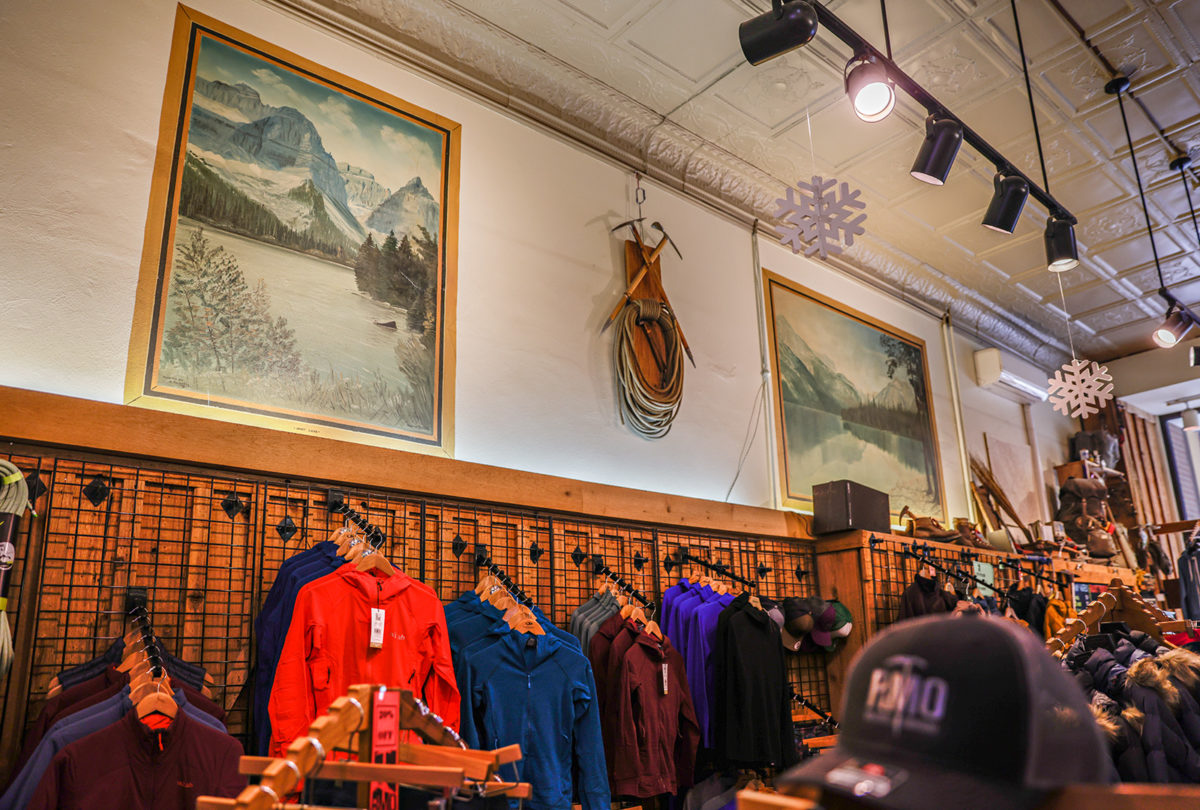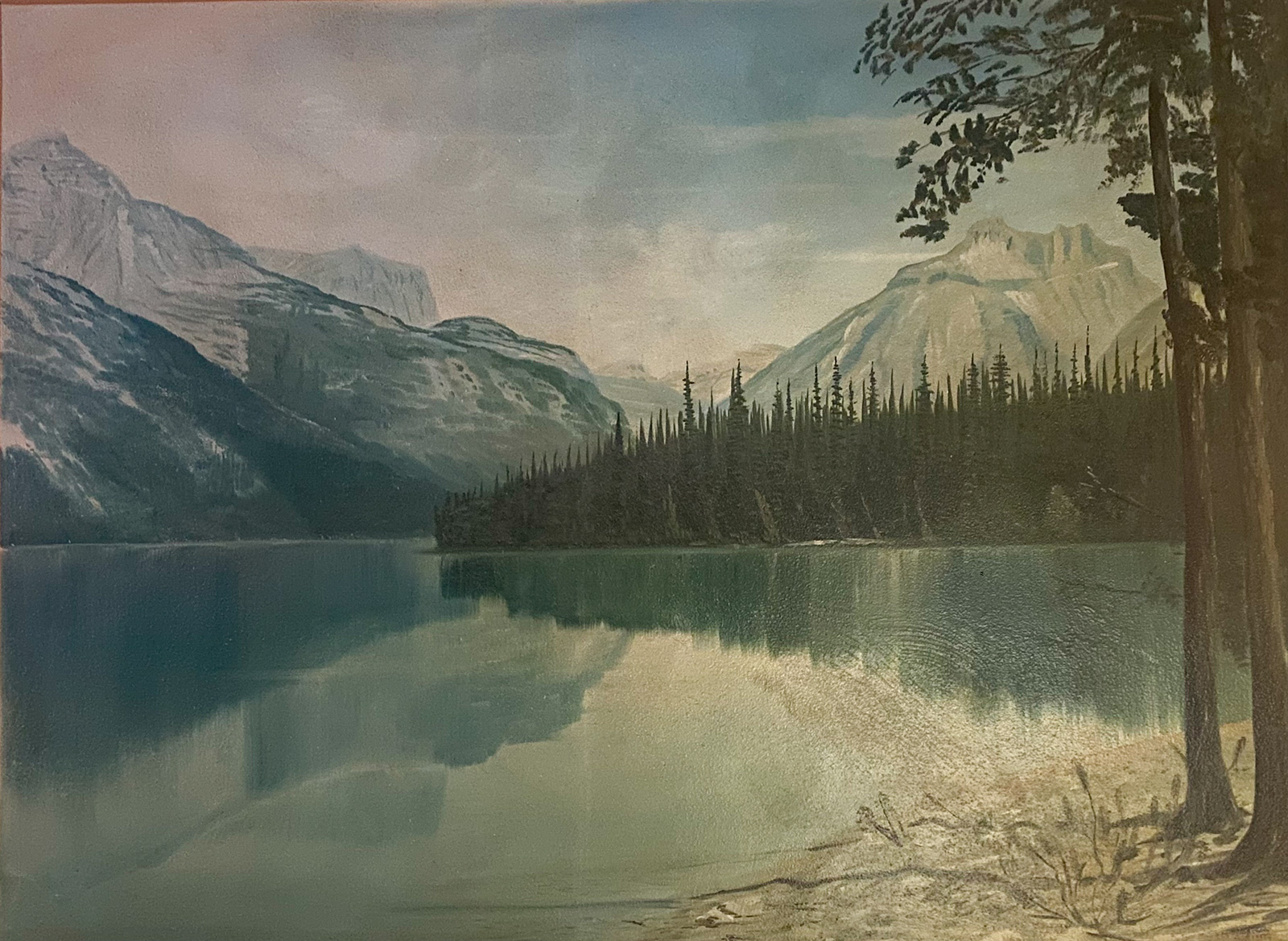At Rocky Mountain Outfitter, the goal is generally for customers to look at the merchandise, not the plaster walls above.
Then again, the walls at the outdoor gear business aren’t exactly normal.
Above the shelves of climbing harnesses, helmets, field repair kits, and whatever else people might need to gear up for their adventures, are a series of murals depicting scenes from Glacier National Park. The eight paintings, which are spaced evenly throughout the first floor and were done directly onto the plaster, all bear the same signature: Clarence Rundell.

Owner Jandy Cox and sales associate Bruce Guthrie haven’t been able to dig up much about Rundell, but what they do know indicates that those murals, faded and cracked in places but still evocative of park’s iconic landscapes, are nearing 100 years old. Rundell’s landscape paintings are 86 years old, to be exact, and in recent weeks Cox and Guthrie decided it was time they got a little more attention.
Guthrie went around and took photographs of each portrait, which he then submitted to Paper Chase print shop so they could be converted into postcards. The postcards are selling for $5 each, or $30 for a pack of eight.
Rundell’s paint strokes were wet, and then drying, and then dry in 1936, when he painted them on the walls of what was then known as the Eagle Shoe company. Cox said based on conversations he’s had with people familiar with the history of the store, the Eagle Shoe company, or Eagle Shoe store, got its name from a pair of bald eagles that a man once traded for boots. The taxidermy eagles are gone now, but they stood watch for years and became an iconic part of the shoe store. The eagles can still be found at the Northwest Montana History Museum.
According to Cox, Don Scharfe, the original owner of Rocky Mountain Outfitter, said that Rundell told him he had painted a mural a day for $25. Guthrie estimates that would’ve been about the equivalent of $500 today. The paintings were done using photos from former Great Northern Railroad photographer T.J. Hileman as a reference, and Rundell even noted that credit in the bottom right corner of each one.
The Montana Historical Society couldn’t find any mention of Rundell in an archival search, but online newspaper archives contain bits and pieces of information about the longtime Flathead Valley resident. The Daily Inter Lake ran a small news item about the completion of the murals in its March 3, 1936 edition with the headline “RUNDELL COMPLETES DECORATIVE SCHEME FOR EAGLE SHOE CO.”
The story is three sentences, with the last one saying “The paintings are finished in natural colors, and lend a general bright appearance to the store.”
Another article about the latest news out of Kila from the March 28, 1940, edition of the Inter Lake dedicates a sentence to Rundell’s visit to an upper school art class to demonstrate painting. A 1965 article notes that he was a charter member of the Painters Local 975 union, but was unable to attend a 30th anniversary dinner party at Orly’s Supper Club. Other editions of the paper mention reunions he attended with family. A snippet from a 1938 edition of the Missoulian says that he and four other people spent the weekend on the North Fork of the Flathead River. “The party returned with some fine mountain trout,” the paper reported.
A more complete picture of Rundell’s life appears in his obituary, which was published in the Missoulian in May of 1984. The obituary mentions that he was born in Hulett, Wyoming in 1905, had four brothers and two sisters, and died at the age of 78 of natural causes in the Montana Veterans Home in Columbia Falls. He moved to Montana in 1923 and until his retirement worked as a painter, including for several years with the Neon Sign. Co.
Rundell, according to his obituary, was a World War II veteran “having served as a painter in the U.S. Air Force in England.”
The Northwest Montana History Museum in Kalispell has a five pane 21-foot-wide mural painted by Rundell in 1961 for the Log Cabin Bar. It’s currently on display on the second floor of the museum and depicts an outdoor scene with a lake. Jacob Thomas, the executive director of the museum, said it was given to the museum by the Hockaday Museum of Art in 2014.
The photographer whose work Rundell used is a much more well-known figure from the past, and the Montana Historical Society archives include both images of his work, and newspaper clippings about his life.
Hileman was a photographer for the Great Northern Railroad, and in addition to photographing landscapes around Glacier, he also took portraits of members of the Blackfeet tribe. An obituary for Hileman says he was born as Tomer J. Hileman in 1882 in Marienville, Pennsylvania. He worked in Chicago, then Colorado, and then in 1911 arrived in Kalispell, and he worked as a photographer for the Great Northern Railroad. A 1960 edition of the Hungry Horse News published 15 years after his death declared him “Famed Photographer of Glacier.” His work has been used as part of the U.S. Geological Survey’s Repeat Photography Project in which scientists took historical photos of the park’s landscape, and then photographed the same places from a similar position in order to document for research landscape and glacial change caused by climate change.
The scenes depicted in Rundell’s murals include Lake McDonald, Upper Two Medicine Lake, Lake Josephine, Upper St. Mary Lake, Scarface Point, Janet Lake, Trick Falls and Upper Kintla Lake. For years no one in the store knew where Scarface Point was, and Guthrie said it’s not a name that’s in use anymore. Scharfe, the previous owner, did find it sometime in the 1980s on the Highline Trail. A framed photo of him walking just below the jutting rock formation sits below the mural depicting the exact same spot.
With their recent decision to highlight the murals, Cox and Guthrie are finding that longtime customers, including some who have been dropping into Rocky Mountain Outfitters for decades, never even knew the murals were there. And even Cox is still discovering new things about the murals.
Only in late February did he finally spot something square tucked back along the shores of St. Mary Lake. The faded brown structure, just a few inches in size, is an old cabin that no longer exists. Cox said he thinks it used to be on Sun Point, near where a boat dock now sits.
“I mean, I’ve looked at these things for 31 years, and I’d never noticed it until yesterday,” Cox said.

